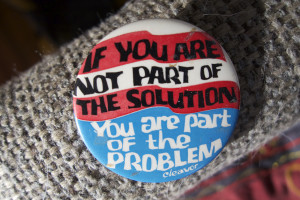Make Art, Not War – Love Mongering
We started our column a year ago with a modification of words from the 1970s song, “War, what is it good for?” and now a year later, we find our connection to art instead of war more relevant than ever. Recent terrorism in Paris and elsewhere has focused global attention on fear and hate and a desire for retaliation. Does every heinous senseless act of murder and destruction require an equally insane response? Is destruction our only course of action to a world on fire? Is there a way to offset the fear mongering we are exposed to 24/7/365?
As headlines swarm around us, rather than devolve into negativity, turn to creativity. We are not so naive as to suggest that art can make all the troubles of the world go away, but art can help people focus on our humanity. “Art is the most essential expression of our humanity . . . . If we don’t have that element, we don’t feel human anymore. This connection to meaning — our inner, intuitive knowledge — is something that endures even in the worst circumstances.
“There are artists working in Syria today: it is not vanity. It’s basic human need,” said Haris Pašović, a Bosnian film director who created a film festival during the siege of Sarajevo in the 1990s.
For those of us who dedicate our energies toward creativity, love of art is the fuel that empowers us. When a person is filled with love, they exhibit that love through their actions. They are happy to share their love with others. They seek approval for their passion, but it is not a requirement that others share the same appreciation. Art generates a love of learning and greater understanding. Art teaches risk taking, learning from one’s mistakes and being open to other possibilities. Art envisions solutions before they become a reality. Art is a way to make the invisible visible.
Art can help us see the world through another’s eyes, which goes a long way to creating understanding and empathy and tearing down the walls built by fear. Art can be a bridge to cultural understanding. It can reach across racial stereotypes, religious barriers and socio-economical levels and prejudices. Seeing another culture’s creative expression allows everyone to be more connected and less isolated.
Belonging to the world of art is as simple as doing what you love and loving what you do. It’s not rocket science, but it does take effort to stand apart from the accepted doom and gloom of the media. Author Kurt Vonnegut said, “Be soft. Do not let the world make you hard. Do not let pain make you hate. Do not let the bitterness steal your sweetness. Take pride that even though the rest of the world may disagree, you still believe it to be a beautiful place.”


Recent Comments